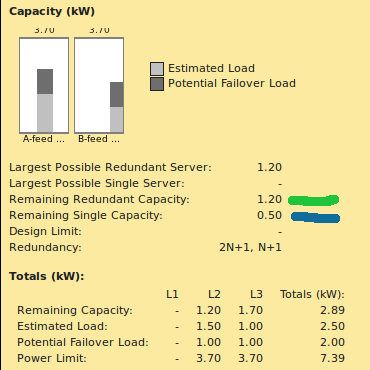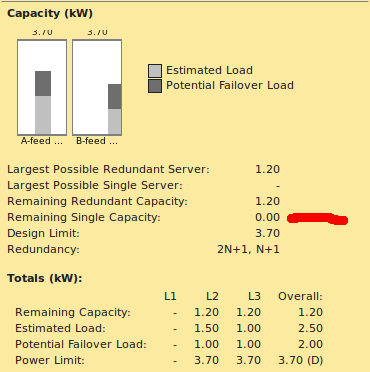Ask our Experts
Didn't find what you are looking for? Ask our experts!
Schneider Electric support forum about installation and configuration for DCIM including EcoStruxure IT Expert, IT Advisor, Data Center Expert, and NetBotz
Search in
Link copied. Please paste this link to share this article on your social media post.
Posted: 2020-07-04 08:37 PM . Last Modified: 2024-04-04 04:07 AM
In previous releases of DCO, the value displayed for the rack power limit when you hovered over the rack, appeared to be automatically calculated by applying the breaker derate value and then taking in to account the redundancy in the rack. It did all this without you having to enter a design limit.
As an example, if you have a pair of 32 amp PDUs installed, your breaker derate value is 0.8, and the rack redundancy is 2N, DCO would automatically calculate a design limit of just over 6kW (32 x 0.8 x 240 / 1000). This made sense because in a 2N environment you would assume the loss of 1 PDU for planning purposes.
Somewhere in a recent release this changed so that DCO assumes both PDUs are involved in a power limit calculation and I assume calculates it along the lines of 2 x 32 x 0.8 x 240 / 1000. This makes no sense for a 2N redundancy situation.
Can anyone shed light on this and if there is a way to revert to the previous calculations?
I know we can set a design limit for the rack but previously this was not required and would involve a significant amount of work to modify all our racks.
Thanks in advance.
(CID:132668009)
Link copied. Please paste this link to share this article on your social media post.
Link copied. Please paste this link to share this article on your social media post.
Posted: 2020-07-04 08:37 PM . Last Modified: 2024-04-04 04:07 AM
Hi David,
That would be the difference on the way DCO capacity is calculated, especially for at 2N power configuration, between earlier version DCO 7.X compared to DCO version 8.X.
One way to look at this for 2N UPS setup: DCO8.X shows the total UPS capacity, whereas DCO 7.X showed the IT load capacity.
In DCO 8.X, while it seems power capacity is calculated as two times, during the calculation of total load, both estimated load and potential failover load are taken.
Example is easier.
A 1kW server with dual power supply will be reserved as 2kW, where:
Estimated load =1kW
Potential Failover load = 1kW
There is a video explaining about the capacity calculation for DCO8.X look at 4:13 onwards on explanation for capacity in 2N with example.
Capacity 2.0 in Data Center Operation v8.0 - Introduction
Leaving this as a comment instead of answer, to see if anyone else can explain it better.
Regards,
Chris
(CID:132668025)
Link copied. Please paste this link to share this article on your social media post.
Link copied. Please paste this link to share this article on your social media post.
Posted: 2020-07-04 08:38 PM . Last Modified: 2024-04-04 04:07 AM
Hi David,
No matter what version of DCO - new or old - we are talking about, the main purpose of the capacity calculations is to find the remaining capacity in a rack, thus aiding you in finding where to put the next server(s) or to give you an idea of how your data center is doing - all other numbers are intermediate results with the purpose to get at the remaining capacity.
In your example, were you are talking about using half of the total power limit for 2N racks, what you are doing is reserving the other half for redundancy purposes. But that is only one way of doing things, you could get to the same 2N remaining capacity by adding up a redundancy reservation for each server, which is what the current DCO is doing, the parameter is called failover load.
If we look at the current DCO (8.2.7) in this light it does recognize when a rack is designed as 2N and gives the correct numbers.
I have created a small example of a rack with 2 rackPDUs each having a power limit of 3695 W and a 2N load of 2000W plus a N load of 500W. You might never have a rack with mixed redundancy like this, but some people do, and this is one of the places were then new version is really helpful:

Notice how it tells you the size of server(s) you can add with 2N redundancy (green) plus it also points out that you can add a additional 500W N server(s) (blue) due to the N server already connected to one of the rackPDUs.
In the next section, notice the heading: "Totals" which means we are no longer talking about redundancy, but total values and if you want to use those for redundancy you have to do the appropriate redundancy reservations yourself (just as you did in you example when you halfed the total rackPDU capacity).
So you do not need to set any desgin limit at all, actually I would advise AGAINST doing so, because you do not gain anything, actually you risk to get wrong results if you do so.
The following example shows why:

I have added a design limit of 3695W (the size of one rackPDU) and notice how I have lost 500W in capacity (marked by red) - which is actually what the old DCO (before 8.0) did...
The design limit is intended for when you want to limit the total estimated load available in the rack below the power limits, e.g. if you want to avoid Asset provisioning adding servers to a specific rack you can limit the rack remaining capacity by setting a design limit.
Regards,
Gert
(CID:132668277)
Link copied. Please paste this link to share this article on your social media post.
Link copied. Please paste this link to share this article on your social media post.
Posted: 2020-07-04 08:38 PM . Last Modified: 2023-10-20 05:07 AM

This question is closed for comments. You're welcome to start a new topic if you have further comments on this issue.
Link copied. Please paste this link to share this article on your social media post.
You’ve reached the end of your document
Create your free account or log in to subscribe to the board - and gain access to more than 10,000+ support articles along with insights from experts and peers.